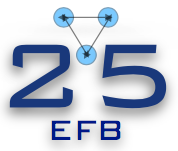Speaker
Description
The High Intensity Gamma-Ray Source (HIGS) at Duke University delivers monoenergetic photon beams with high linear or circular polarization by backscattering of free-electron laser (FEL) photons [1]. To exploit the unique capabilities of this facility, we are conducting an ambitious program of Compton scattering studies on light nuclei aimed at determining the nucleon electromagnetic polarizabilities. Our cryogenic target can liquefy $^{1}$H, $^{2}$H, and $^{4}$He for the purpose of Compton scattering, and we have recently upgraded the cooling (and recovery) system to enable us to liquefy $^{3}$He as well. To measure the scattered photons, we have implemented two of the world’s largest NaI detectors -- BUNI (from Boston University) and DIANA (from University of Kentucky) -- each having better than 2% photon energy resolution. We are also using an array of medium-sized NaI detectors to enhance our angular coverage and to serve as out-of-plane detectors for polarized photon measurements.
Initial experiments have been performed on $^{2}$H and $^{4}$He below 85 MeV with unpolarized photons [2,3]. Experiments on $^{2}$H will elucidate the EM polarizabilities of the neutron ($\alpha_{n}$ and $\beta_{n}$) and provide high precision data for comparison with chiral Effective Field Theory calculations [4]. We have obtained data on $^{2}$H at two incident photon energies covering two backward angles ($150^{\circ}$ and $115^{\circ}$) with BUNI and DIANA and four forward angles with the other NaI detectors. The analysis of these two data sets is nearing completion.
In our first polarization experiment, we measured the photon beam asymmetry using linearly polarized photons at 81 MeV on the proton at three polar angles ($55^{\circ}$, $90^{\circ}$, $125^{\circ}$). These data enabled us to accomplish one of the first extractions of the proton polarizabilities ($\alpha_{p}$ and $\beta_{p}$) from polarized data [5], and our results are compared to independent data from Mainz [6].
An approved experiment for unpolarized Compton scattering on $^{3}$He will constitute the first Compton data ever taken on a $^{3}$He target and will start running in Summer 2023. This will provide an alternate means of accessing the neutron EM polarizabilities in an entrance channel independent of the usual deuteron experiments. This is the motivation for the cryotarget upgrade to enable liquefying $^{3}$He, which requires a lower base temperature than $^{4}$He.
Overall, our Compton scattering program at HIGS is fairly broad, and this talk will provide an overview of the experimental activities. The results of our recent work will be reviewed, some preliminary data from our ongoing measurements will be shown, and prospects for future experiments and their impact will be discussed.
[1] H.R. Weller et al., “Research Opportunities at the Upgraded HIGS Facility,” Prog. Part. Nucl. Phys. 62, 257 (2009).
[2] X. Li et al., “Compton Scattering from $^{4}$He at the TUNL HIGS Facility,” Phys. Rev. C101, 034618 (2020).
[3] M.H. Sikora et al., “Compton Scattering from $^{4}$He at 61 MeV,” Phys. Rev. C96, 05209 (2017).
[4] H.W. Griesshammer et al., “Using Effective Field Theory to Analyse Low-Energy Compton Scattering Data from Protons and Light Nuclei,” Prog. Part. Nucl. Phys. 67, 841 (2012).
[5] X. Li et al., “Proton Compton Scattering from Linearly Polarized Gamma Rays,” Phys. Rev. Lett. 128, 132502 (2022).
[6] E. Mornacchi et al., “Measurement of Compton Scattering at MAMI for the Extraction of the Electric and Magnetic Polarizabilities of the Proton,” Phys. Rev. Lett. 128, 132503 (2022).

